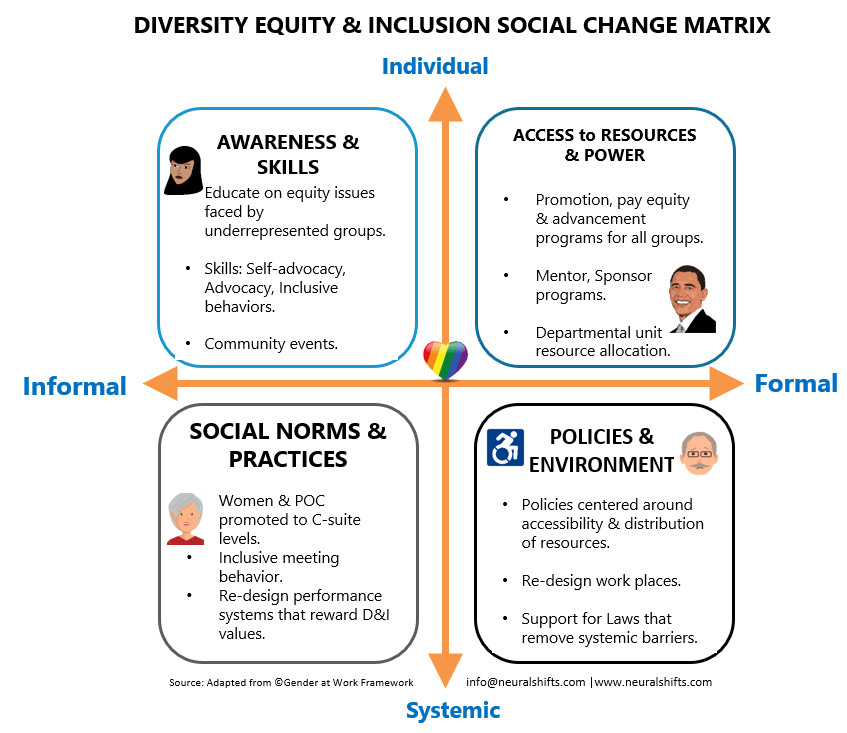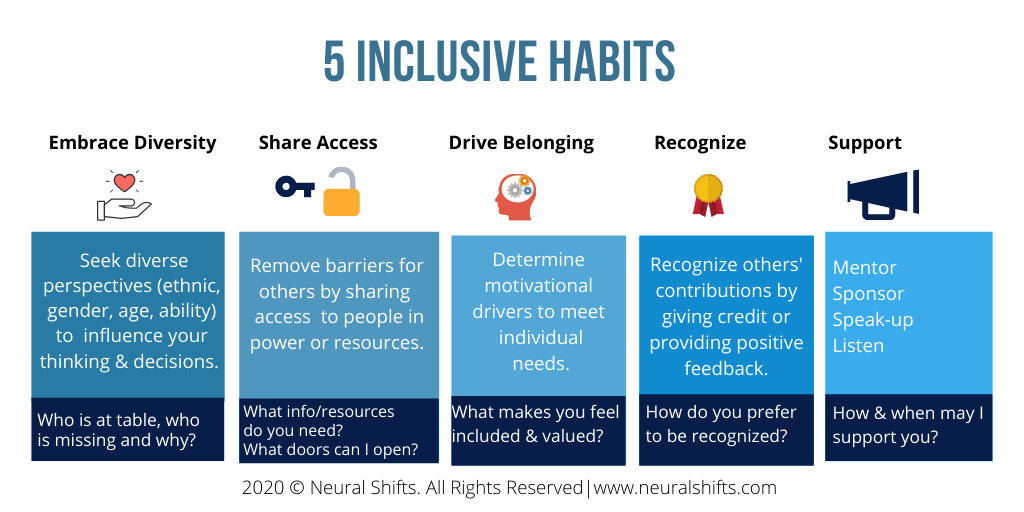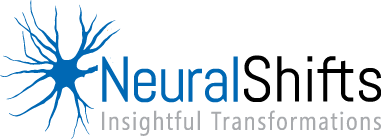Want to Drive Diversity Equity & Inclusion but Don’t Know Where to Start?
I often hear from folks who want to start doing Diversity Equity & Inclusion (DEI) actions but don’t know where to start or think their only option is putting employees through unconscious bias training. The first group is overwhelmed by the options and those who opt for the second option eventually lead their organizations to Diversity & Inclusion (D&I) fatigue.
I recommend starting with an assessment of organizational practices & involving employees in focus groups from the beginning to set a space for employees’ voices to count throughout the planning and implementation processes. Some reluctantly agree, while others move forward with great intentions offering training that backfire. I also recommend working with a communications person to craft the communications strategy supporting the efforts.
Everyone will benefit if those with great intentions can land on a plan tailored to their specific organizational culture & align with their business strategy. Thus, I decided to share a framework I use to measure diversity and inclusion progress, keep focus & and allow others to visualize the impact.
When you embarked on Diversity, Equity & inclusion efforts you are driving social change & visibly contributing to the business bottom line. Thus, a well-crafted & executed DEI strategy must be plotted across the following four quadrants of social change to ensure meaningful progress. Because biased behavior and power dynamics are embedded in the culture of every organization, shifting them requires addressing systemic and individual changes all at once. Every effort you launch must fall under one of these four quadrants.

The first domain is Awareness & Skills. Employee training falls under this domain.
Goals for training initiatives are:
- Raise employees’ knowledge about historical issues underrepresented groups face & the universal rights that must be honored.
- Develop the skills to foster an inclusive & diverse environment by creating sponsors, advocates, and allies especially those who hold privilege.
- Increase self-advocacy on the part of underrepresented groups to achieve better conditions.
Strategies. - Ensure all your employees attend training on unconscious bias, allyship, inclusive leadership, inclusive hiring & accessibility.
- Support your managers in developing facilitation skills to foster interracial dialogue, remove biases from decisions & advocate for others.
- Track formal and informal opportunities for your employees to receive information about these topics such as public or community events.
- Train employees on allyship skills, conflict management, inclusive leadership skills, etc.
The second domain is Access to resources and power. Take a systemic view of your practices & structure to remove the “red tape” that prevents individuals from acquiring information/resources or accruing social capital which will enable them to succeed in the organization.
Strategies
- Find ways to create a fair distribution of power by addressing inequities in managerial promotions.
- Examine your data around promotions & pay equity to uncover gender and racial gaps that may prevent employees from occupying positions in power.
- Launch initiatives such as leadership development, mentorship, and sponsorship to give underrepresented groups access to education and connections to people in power..
The third domain is Social norms & inclusive practices. Here is where your leadership & employees get to act on their commitment to foster inclusive workplaces & achieve equity. Your responsibility is to shift the culture from exclusionary behaviors that lead to few having power & create incentive systems that reward new behaviors and/or discourages exclusionary behaviors.
This requires not just communication across the organization but also re-design of your organizational reporting structures & spaces ensuring accessibility to drive social norms. You will know that you have made progress when your employees can call out biased behavior without feeling afraid of retribution and engage in honest dialogue to foster inclusion. We use social science research insights & practices to help you accomplish this.
Strategies
To ensure success, leaders must begin to model the behaviors by increasing their knowledge, sponsoring individuals, attending D&I events & practicing the following five inclusive habits.
- Embrace diversity by seeking new perspectives & challenging the status quo. Engage in team conversations about D&I topics, share your pronouns, create open space for safe conversations.
- Share access by removing barriers in terms of information, budget, or access to those in power. Many times, people become gatekeepers within their organizations because they possess information, social capital, or monetary resources and forget to share those resources, therefore accruing power and inhibiting others from succeeding. Stop playing favorites and ensure everyone has the resources to succeed.
- Drive belonging by asking everyone on your team “what makes you feel included and valued?” to identify personal drivers and not operating from rules of thumb that may not apply to everyone.
- Recognize others’ contributions by giving credit where credit is due and providing positive feedback. In many organizations power is held by those who steal credit from their contributors. This is a well-known issue that carries a significant amount of gender bias.
- Support: informal mentoring and sponsoring relationships can increase underrepresented groups’ visibility in the social system and increase their chances to climb the ladder.

Inclusive practices must center on achieving representation and fostering inclusion across all departments in the organization. It can be instituted at both individual and group levels.
Strategies
- Programs addressing inclusive hiring of autistic individuals, other disAble groups and veterans are systemic approaches to driving equity.
- Inclusive meeting programs to neutralize power dynamics & drive innovation.
- Re-designing performance systems to reward inclusive behaviors and the recruitment and promotion of underrepresented groups is necessary to avoid managers recruiting diverse candidates but not developing their careers.
- Marketing should ensure representation & accessibility in all the content produced to reflect the D&I values embedded in your brand.
- Procurement can seek ways to minimize barriers for businesses from underrepresented individuals to achieve supplier diversity.
- Engineering must adopt inclusive innovation practices to create products that meet the needs of all including underrepresented folks.
The fourth domain is policies & environment. Organizations must review and update policies & procedures to drive equity for underrepresented groups.
Strategies
- At the organizational level is important to craft new policies around flexible conditions for working mothers, parental leave, accessibility for employees with disAbilities, or medical support for transgender individuals & others.
- The physical office environment should reflect the policies providing access to buildings for disabled individuals, technological assistance for disabled individuals, mother rooms, gender-neutral restrooms, etc.
- At the geopolitical level, your organization must participate or support advocating for equal rights for underrepresented groups. Great examples are Brad Smith, Microsoft’s legal challenge to the termination of the DACA program impacting Latinx communities & Marc Benioff, Salesforce CEO successful boycott of Indiana’s discriminatory LGBTQ law that led to revisions to the legislation and a win for the LGBTQ community.
This work will not progress without continuous engagement with employees driving transparency. It’s essential to establish mechanisms for feedback asking your employees to rate your impact in the four domains.
Finally, if you need resources to continue the work, use this framework to plan your strategies, measure progress, and communicate organizational impact. You will know that you are making progress when your workforce is more diverse, employees stop objecting to diverse hires saying they don’t want to “lower” the bar, and all forms of discrimination & harassment disappear.
Is your company delivering in all four domains? I’d love to hear your thoughts on initiatives that you are driving forward.




0 Comments